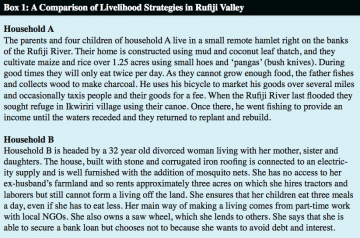Key Findings from the Rufiji study, NCAP Tanzania project.

Over 90% of households indicated that they relied upon means other than agriculture to survive flood and drought. All households interviewed indicated that agriculture did not provide enough food to last all year round even during “good” years. Given that agriculture in Rufiji accounts for 80% of all economic activity, this leads to the assumption that households in Rufiji must diversify their labor activities to gain access to food beyond their immediate means of production.
The majority of households in the study area are considered to be very poor and vulnerable with low access to livelihood assets. This is a major concern in terms of food security, poverty reduction and climate change adaptation as poor asset holdings is a major constraint on livelihood diversification and sustainability. The findings below indicate that in Rufiji, education and health status play an overwhelming part in assets, strongly determining resilience.
The importance of education is highlighted by the comparison of different livelihood strategies in the figure below. The activities practiced by Household A consist of low income strategies while in Household B there is a mixture of high and middle income band strategies. The key difference in human capital is that no members of Household A have any formal education while the divorced head of Household B has some secondary level education.
Aside from being low income, the strategies practiced by household A are climate sensitive. People who rely on forest resources during the dry season or during severe droughts flood local markets with the same products, so prices drop. The case study demonstrates that educational status improves access to income generation from an ad hoc array of strategies towards more reliable or formal income streams.

Gender
Gender roles are also important determinants of vulnerability in Rufiji. A total of 16.3% of households surveyed were headed by unmarried, divorced and widowed women. Interview and daily calendar data indicate that the division of labor within households is such that women wake earlier and go to sleep later than their husbands as they must attend to domestic and cultivation chores.
Men on the other hand spend less time in the field, have more time to socialize and focus on the marketing of crops and charcoal. Given women’s predisposition towards socially reproductive tasks, unmarried, divorced and widowed women can be considered particularly vulnerable as time constraints and social norms may act to exclude them from income generation activities usually practiced by men. In addition, female households also face exclusion from essential resources needed to generate a livelihood. The expulsion from her ex-husband’s land and home would seriously have compromised the sustainability of Household B had it not been for the good fortunes brought about by her educational background. One interviewee told of her friend from school who was shamed after becoming pregnant while unmarried. She was disowned by her family and friends and ultimately forced to beg for money and food.
(0) Comments
There is no content